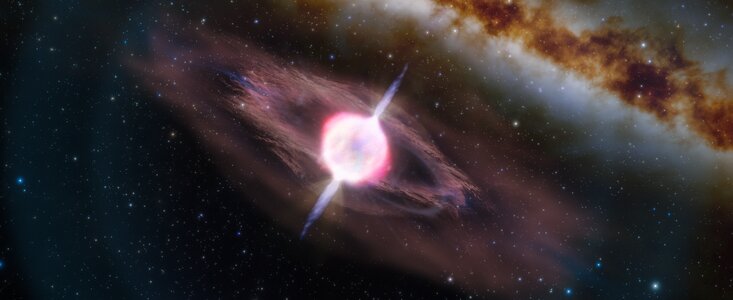

Fireworks in the Universe with a record and a twist
26 July 2021
Have you ever heard about gamma-ray bursts? They are huge explosions at the heart of distant galaxies — in fact, the most energetic and brightest events in the whole Universe! These bursts can last from a few milliseconds to several hours.
Astronomers classify these events into two general categories: short gamma-ray bursts last less than two seconds and are believed to result from the merging of neutron stars. Long gamma-ray bursts last longer than those two seconds and are believed to start with supernova explosions (caused by the death of massive stars).
A team using the Gemini Observatory has just found that gamma-ray bursts do not always fit the boxes astronomers have created for them. They saw a 0.6-second gamma-ray burst coming from a supernova explosion in a distant galaxy — the shortest ever seen for this kind!
Scientists believe that supernovae gamma-ray bursts like this are this short because gamma-ray jets are not strong enough to entirely escape the star, almost failing to create a burst. Some collapsing stars have such weak jets that they don’t even produce gamma-ray bursts at all.
There’s a tweak to the story: the discovery can help explain a mystery in astronomy. Long gamma-ray bursts are normally believed to come from a specific kind of supernova (Type Ic-BL). However, there are many more of these supernovae than long gamma-ray bursts. Maybe these supernovae could be hiding short gamma-ray bursts instead of the long ones astronomers would expect to find.
And maybe sorting gamma-ray bursts by their duration is not the best way to classify them — there’s a lot more to look for when it comes to what causes these bursts!
Cool Fact
Gamma-ray bursts are extremely rare phenomena — but when they do happen, they release an incredible amount of energy. In just a few seconds, a typical gamma-ray burst can release more energy than our Sun will in its 10-billion year lifetime!
Image: The illustration shows a collapsing star producing short gamma-ray jets before it explodes as a supernova.
Credits: International Gemini Observatory/NOIRLab/NSF/AURA/J. da Silva. Image processing: M. Zamani (NSF's NOIRLab)
